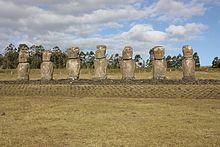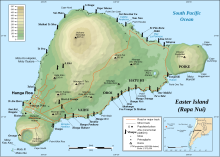 At Ahu Akivi, the moai face the ocean. Although the platform is clearly visible, the overgrown grass obscures the pattern of the sloping pavement. | |
 | |
| 27°6′54″S 109°23′42″W / 27.11500°S 109.39500°W | |
| Location | Easter Island |
|---|---|
| Designer | Rapanui people |
| Type | Sacred stone statues |
| Material | Volcanic rock |
| Length | 70m |
| Height | 16 ft |
| Beginning date | Originally 15th century |
| Completion date | Restored in 1960 |
| Dedicated to | Make Make worship |


Ahu Akivi is a particular sacred place on the Chilean island of Rapa Nui (or Easter Island), looking out towards the Pacific Ocean. The site has seven moai, all of equal shape and size, and is also known as a celestial observatory that was set up around the 16th century. The site is located inland, rather than along the coast. Moai statues were considered by the early people of Rapa Nui as their ancestors or Tupuna that were believed to be the reincarnation of important kings or leaders of their clans. The Moais were erected to protect and bring prosperity to their clan and village.[1]
A particular feature of the seven identical moai statues is that they exactly face sunset during the Spring Equinox and have their backs to the sunrise during the Autumn Equinox. Such an astronomically precise feature is seen only at this location on the island.[1]
- ^ a b "Easter Island: stones, history. Easter Island". Lost Civilizations.net. Retrieved 13 August 2013.